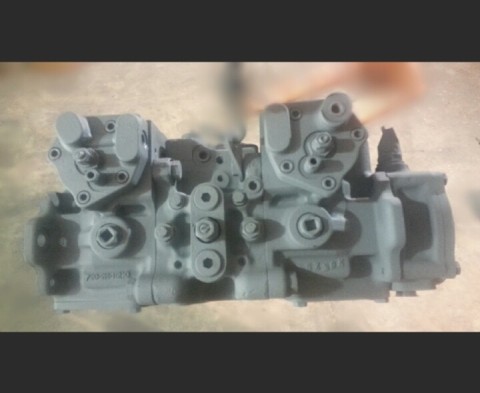Sundstrand Sauer Danfoss Series 40 – Start up & Maintenance

Sundstrand Sauer Danfoss Series 40 – Start up & Maintenance
May 19, 2016 Comments Off on Sundstrand Sauer Danfoss Series 40 – Start up & MaintenanceAt our Hydrostatic Pump Repair Site, we offer many types of Hydrostatic Transmission Repair and information relating to Hydrostatic Parts
Today we will discuss:
Sundstrand Sauer Danfoss Series 40 – Start up & Maintenance
| Fluids
Hydraulic fluids used with Sundstrand-Sauer Hydrostatic Transmission products should be selected with assistance from a reputable supplier, (Hydrostatic Transmission),following the guidelines presented in the “Fluid Quality Requirements” bulletin, BLN-9887. Start-Up Procedure It is important to follow the procedures for a new Series 40 – Sundstrand Sauer Hydrostatic Transmission for installing or restarting an installation on a pump or motor that has been detached from a Sundstrand system. CAUTION Quick Tip- the vehicle/machine is to be disabled uplift the wheels off the ground and turn the machine off. Then it is safe to proceed to performing the process in order to prevent injury to the mechanic or anyone standing by. Therefore, take the crucial safety precautions before moving the vehicle/machine. Before installing the pump and/or motor, examine the units for damage incurred during shipping and handling. Make sure all the system components are clean preceding filling it with fluid. (reservoir, hoses, valves, fittings, heat exchanger). Fill the reservoir with suggested hydraulic fluid, which should be passed through a 10-micron (no bypass) filter prior to the ingoing fluid to the reservoir. Fluids that are containing foreign particle will cause damage to the components, and may be the reason in unexpected vehicle/machine movement. The inlet line that leads from the reservoir to the pump should be filled before start up and make sure the inlet lines have tight fittings, free of restrictions and air leaks. Very important: to fill the pump and/or motor housing with clean hydraulic fluid before the start up. Fill the housing up with filtered oil in the upper case drain port. It is suggested to Install a 0 to 500 PSI (35 BAR) pressure gauge to observe the charge pressure during start-up. It is suggested by Hydrostatic Transmssion,LLC that the outer control input signal (connection for MDC, hydraulic lines for HOC and electrical connections for EDC) be detached at the pump control until initial start-up is satisfactory. This allows the pump to remain in neutral position. “Nudge” or slowly turn prime mover pending charge pressure starts to rise. Running the prime mover at the lowest possible RPM until desired charge pressure has been reached. Bleed air from lines through the high pressure gauge ports.
|
|||||||||||||||||||||||||||||||||
| WARNING
Never start prime mover unless the pump is in neutral position,(0° swash plate angle). Always adhere to safety suggestions to ensure to prevent the machine from moving in case pump is put into motion during initial start up. Once charge pressure has been recognized, raise speed to normal operating RPM. Charge pressure should be roughly 220-PSI (15.2 BAR) minimum. If charge pressure is inaccurate, shut down and determine the cause. WARNING Not enough charge pressure will make the operator’s capability to control the vehicle/machine. Hydrostatic Transmision, LLC recommended manufactured suggestion to shut down prime mover and attach external control input signal. Start prime mover, while pump is in neutral, then at normal operating speed, gradually check for forward and reverse machine maneuver. The PSI of 220 to 240 (15.2 to 16.52) charge pressure should remain throughout forward or reverse operation. It is recommended to do this for at least five (5) minutes. Then shut down prime mover, remove gauges, and plug ports to check reservoir level and add fluid if needed. Transmission is ready for operation now. Maintenance To insure best possible service life a Sundstrand Sauer Hydrostatic Transmissions Series 40 – products, standard protection of the fluid and filter must be checked regularly. Checking the tank each day for proper fluid level is important so that, the presence of water (a cloudy to milky appearance, or water in bottom of tank), and stale fluid odor (representing extreme heat) do not occur. The manufacturer’s recommend that the fluid and filter be changed at the following increments: System with a sealed tank – 2000 hrs. System with a break in the seal tank – 500 hrs. If the fluid becomes tainted with foreign matter (dirt, water, grease, etc.) or if the fluid has been subjected to temperature levels greater than the maximum recommended, it is suggested to change the fluid more often than what is normally done. Reusing fluid is never recommended. The filter should be changed when the fluid is changed or if the filter gauge shows it is necessary to do so. |
|||||||||||||||||||||||||||||||||
| leave us a comment or you can call us at 800-361-0068
sales@hydrostatic-transmission.com |
|||||||||||||||||||||||||||||||||